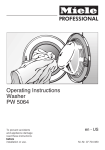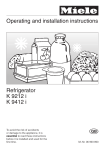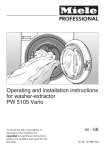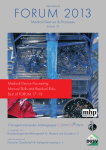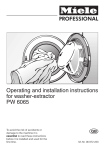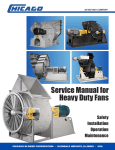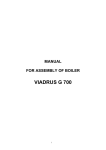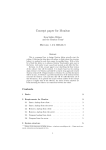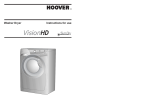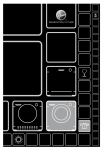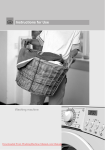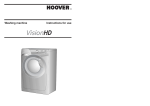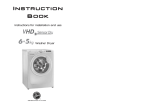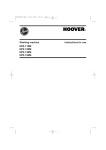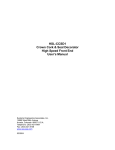Download PW 5064 user manual - First Choice Marshalls
Transcript
Operating and installation instructions for washer-extractor PW 5064 To avoid the risk of accidents or damage to the machine it is essential to read these instructions before it is installed and used for the first time. en - GB M.-Nr. 07 320 530 Caring for the environment Disposal of the packing material The transport and protective packing has been selected from materials which are environmentally friendly for disposal and can normally be recycled. Recycling packaging materials saves raw materials and reduces the amount of waste produced. Rather than just throwing these materials away, please ensure they are recycled. Ensure that any plastic wrappings, bags, etc are disposed of safely and kept out of the reach of babies and young children. Danger of suffocation. Disposing of your old machine Electrical and electronic machines often contain materials which, if handled or disposed of incorrectly could be potentially hazardous to human health and to the environment. They are, however, essential for the correct functioning of your machine. Please do not therefore dispose of it with your household waste. Please dispose of it at your local community waste collection/recycling centre or contact your dealer for advice. Ensure that it presents no danger to children while being stored for disposal. 2 It should be unplugged or disconnected from the mains electricity supply by a competent person. Energy saving tips Energy and water consumption – Water consumption and energy usage are determined by the size of the load. To make the most out of your machine load the maximum dry load for the programme you are using. Detergent – Do not exceed the amounts of detergent recommended by the manufacturer on the packaging. – Reduce the amount of detergent for smaller loads. When drying with a tumble dryer Selecting the highest possible spin speed for the wash programme will save energy when drying in a tumble dryer afterwards. Contents Caring for the environment . . . . . . . . . . . . . . . . . . . . . . . . . . . . . . . . . . . . . . . . . . 2 Warning and Safety instructions . . . . . . . . . . . . . . . . . . . . . . . . . . . . . . . . . . . . . 6 Operating the washing-extractor . . . . . . . . . . . . . . . . . . . . . . . . . . . . . . . . . . . . 10 Control panel . . . . . . . . . . . . . . . . . . . . . . . . . . . . . . . . . . . . . . . . . . . . . . . . . . . . . 10 Display . . . . . . . . . . . . . . . . . . . . . . . . . . . . . . . . . . . . . . . . . . . . . . . . . . . . . . . . . . 11 Before using for the first time. . . . . . . . . . . . . . . . . . . . . . . . . . . . . . . . . . . . . . . 12 How to wash correctly . . . . . . . . . . . . . . . . . . . . . . . . . . . . . . . . . . . . . . . . . . . . . 13 Brief instructions . . . . . . . . . . . . . . . . . . . . . . . . . . . . . . . . . . . . . . . . . . . . . . . . . . 13 Spinning . . . . . . . . . . . . . . . . . . . . . . . . . . . . . . . . . . . . . . . . . . . . . . . . . . . . . . . . 18 Maximum final spin speed . . . . . . . . . . . . . . . . . . . . . . . . . . . . . . . . . . . . . . . . . . . 18 Rinse and interim spin . . . . . . . . . . . . . . . . . . . . . . . . . . . . . . . . . . . . . . . . . . . 18 To omit the final spin (Rinse hold) . . . . . . . . . . . . . . . . . . . . . . . . . . . . . . . . . . 18 To omit the spin between rinses and the final spin . . . . . . . . . . . . . . . . . . . . . 18 Delay start. . . . . . . . . . . . . . . . . . . . . . . . . . . . . . . . . . . . . . . . . . . . . . . . . . . . . . . 19 Programme chart . . . . . . . . . . . . . . . . . . . . . . . . . . . . . . . . . . . . . . . . . . . . . . . . . 20 Programme sequence . . . . . . . . . . . . . . . . . . . . . . . . . . . . . . . . . . . . . . . . . . . . . 24 Pre-spin . . . . . . . . . . . . . . . . . . . . . . . . . . . . . . . . . . . . . . . . . . . . . . . . . . . . . . . . . 25 Pre-wash/Pre-rinse. . . . . . . . . . . . . . . . . . . . . . . . . . . . . . . . . . . . . . . . . . . . . . . . . 25 Anti-crease. . . . . . . . . . . . . . . . . . . . . . . . . . . . . . . . . . . . . . . . . . . . . . . . . . . . . . . 25 Changing the programme sequence . . . . . . . . . . . . . . . . . . . . . . . . . . . . . . . . . 26 Cancelling a programme . . . . . . . . . . . . . . . . . . . . . . . . . . . . . . . . . . . . . . . . . . . . 26 Changing a programme . . . . . . . . . . . . . . . . . . . . . . . . . . . . . . . . . . . . . . . . . . . . 26 Adding or removing laundry after a programme has started . . . . . . . . . . . . . . . . 27 Detergent . . . . . . . . . . . . . . . . . . . . . . . . . . . . . . . . . . . . . . . . . . . . . . . . . . . . . . . 28 Water softeners . . . . . . . . . . . . . . . . . . . . . . . . . . . . . . . . . . . . . . . . . . . . . . . . . . . 28 3 Contents Fabric conditioner or liquid starch . . . . . . . . . . . . . . . . . . . . . . . . . . . . . . . . . . . . . 28 Colour run and dye removers/dyes . . . . . . . . . . . . . . . . . . . . . . . . . . . . . . . . . . . . 29 External dispensing system . . . . . . . . . . . . . . . . . . . . . . . . . . . . . . . . . . . . . . . . . . 30 Empty sensor . . . . . . . . . . . . . . . . . . . . . . . . . . . . . . . . . . . . . . . . . . . . . . . . . . 31 Cleaning and care . . . . . . . . . . . . . . . . . . . . . . . . . . . . . . . . . . . . . . . . . . . . . . . . 32 Cleaning the machine . . . . . . . . . . . . . . . . . . . . . . . . . . . . . . . . . . . . . . . . . . . . . . 32 Cleaning the water inlet filters . . . . . . . . . . . . . . . . . . . . . . . . . . . . . . . . . . . . . . . . 34 Problem solving guide . . . . . . . . . . . . . . . . . . . . . . . . . . . . . . . . . . . . . . . . . . . . 35 What to do, if . . . . . . . . . . . . . . . . . . . . . . . . . . . . . . . . . . . . . . . . . . . . . . . . . . . . . 35 The programme does not start . . . . . . . . . . . . . . . . . . . . . . . . . . . . . . . . . . . . . . . 35 Fault messages in the display . . . . . . . . . . . . . . . . . . . . . . . . . . . . . . . . . . . . . . . . 36 General problems . . . . . . . . . . . . . . . . . . . . . . . . . . . . . . . . . . . . . . . . . . . . . . . . . 37 An unsatisfactory wash result . . . . . . . . . . . . . . . . . . . . . . . . . . . . . . . . . . . . . . . . 38 The drum door cannot be opened by pressing the Door button. . . . . . . . . . . . . . 39 Opening the drum door in the event of a blocked drain outlet and/or power failure . . . . . . . . . . . . . . . . . . . . . . . . . . . . . . . . . . . . . . . . . . . . . . . . . . . . . 40 After sales service . . . . . . . . . . . . . . . . . . . . . . . . . . . . . . . . . . . . . . . . . . . . . . . . 41 PC / Optical interface. . . . . . . . . . . . . . . . . . . . . . . . . . . . . . . . . . . . . . . . . . . . . . . 41 Optional accessories . . . . . . . . . . . . . . . . . . . . . . . . . . . . . . . . . . . . . . . . . . . . . . . 41 Installation and connection . . . . . . . . . . . . . . . . . . . . . . . . . . . . . . . . . . . . . . . . 42 Front view. . . . . . . . . . . . . . . . . . . . . . . . . . . . . . . . . . . . . . . . . . . . . . . . . . . . . . . . 42 Rear view . . . . . . . . . . . . . . . . . . . . . . . . . . . . . . . . . . . . . . . . . . . . . . . . . . . . . . . . 43 Installation on a raised plinth . . . . . . . . . . . . . . . . . . . . . . . . . . . . . . . . . . . . . . . . . 44 Washer-dryer stack . . . . . . . . . . . . . . . . . . . . . . . . . . . . . . . . . . . . . . . . . . . . . . . . 44 Installation surface . . . . . . . . . . . . . . . . . . . . . . . . . . . . . . . . . . . . . . . . . . . . . . . . . 45 Installing the washer-extractor. . . . . . . . . . . . . . . . . . . . . . . . . . . . . . . . . . . . . . . . 45 Removing the transit struts . . . . . . . . . . . . . . . . . . . . . . . . . . . . . . . . . . . . . . . . . . 45 Re-fitting the transit struts . . . . . . . . . . . . . . . . . . . . . . . . . . . . . . . . . . . . . . . . . . . 47 Levelling the machine . . . . . . . . . . . . . . . . . . . . . . . . . . . . . . . . . . . . . . . . . . . . . . 48 4 Contents Plumbing . . . . . . . . . . . . . . . . . . . . . . . . . . . . . . . . . . . . . . . . . . . . . . . . . . . . . . . . 49 Connection to the cold water supply . . . . . . . . . . . . . . . . . . . . . . . . . . . . . . . . 49 Connection to the hot water supply . . . . . . . . . . . . . . . . . . . . . . . . . . . . . . . . . 50 Connection to drainage . . . . . . . . . . . . . . . . . . . . . . . . . . . . . . . . . . . . . . . . . . . . . 50 Electrical connection U.K. . . . . . . . . . . . . . . . . . . . . . . . . . . . . . . . . . . . . . . . . . . . 51 Technical data . . . . . . . . . . . . . . . . . . . . . . . . . . . . . . . . . . . . . . . . . . . . . . . . . . . 52 Settings menu J. . . . . . . . . . . . . . . . . . . . . . . . . . . . . . . . . . . . . . . . . . . . . . . . . . 54 Suds cooling . . . . . . . . . . . . . . . . . . . . . . . . . . . . . . . . . . . . . . . . . . . . . . . . . . . . . 54 Display contrast . . . . . . . . . . . . . . . . . . . . . . . . . . . . . . . . . . . . . . . . . . . . . . . . . . . 54 Display brightness . . . . . . . . . . . . . . . . . . . . . . . . . . . . . . . . . . . . . . . . . . . . . . . . . 54 Settings/Supervisor level menu . . . . . . . . . . . . . . . . . . . . . . . . . . . . . . . . . . . . . 55 Enter code . . . . . . . . . . . . . . . . . . . . . . . . . . . . . . . . . . . . . . . . . . . . . . . . . . . . . . . 55 Change code . . . . . . . . . . . . . . . . . . . . . . . . . . . . . . . . . . . . . . . . . . . . . . . . . . . . . 55 Language J and further settings. . . . . . . . . . . . . . . . . . . . . . . . . . . . . . . . . . . . . . 56 5 Warning and Safety instructions This machine conforms to current safety requirements. Inappropriate use can, however, lead to personal injury and damage to property. To avoid the risk of accidents and damage to the machine, please read these instructions carefully before using it for the first time. They contain important information on its safety, use and maintenance. Keep these instructions in a safe place and ensure that new users are familiar with the content. Pass them on to any future owner. Correct application ~ Only use the machine to wash items which are specified by the manufacturer to be machine-washable on the wash-care label, and textiles composed of hand-washable wool or wool blend fabrics as well as satin, lace, silk and other hand-washable garments. Any other applications may be dangerous. The manufacturer cannot be held liable for damage resulting from incorrect or improper use of the machine. ~ This machine must be used as described in these operating instructions and must be checked on a regular basis to make sure it is functioning correctly. Maintenance must be carried out when necessary. 6 ~ It is the operator's responsiblity to ensure that the standard of disinfection in thermal as well as chemo thermal procedures is maintained (in accordance with § 18 IFSG) by carrying out suitable validation tests. Disinfection programmes must not be interrupted, as this can have a limiting effect on the disinfection result. ~ This machine is not intended for use by persons (including children) with reduced physical, sensory or mental capabilities, or lack of experience and knowldege, unless they have been shown how to use it by a person responsible for their safety. Safety with children ~ Keep children away from the machine at all times. It is not a toy! To avoid the risk of injury do not allow children to play on or near it or to play with its controls. Supervise its use by the elderly or infirm, and supervise children whilst you are using it. ~ Older children may only use the machine if its operation has been clearly explained to them and they are able to use it safely, recognising the dangers of misuse. ~ For machines with a 'porthole' door, remember that the porthole glass will be hot when washing at very high temperatures Do not let children touch it. Warning and Safety instructions Technical safety ~ Before setting up the machine, check it for any externally visible damage. Do not install or use a damaged machine. ~ Before connecting the machine, ensure that the connection data on the data plate (voltage and connected load) match the mains electricity supply. If in any doubt, consult a qualified electrician. ~ The electrical safety of this machine can only be guaranteed when continuity is complete between the machine and an effective earthing system which complies with current local and national safety regulations. It is most important that this basic safety requirement is present and regularly tested, and where there is any doubt the household wiring system should be inspected by a qualified electrician. The manufacturer cannot be held liable for the consequences of an inadequate earthing system (e.g. electric shock). ~ Do not connect the machine to the mains electricity supply by an extension lead. Extension leads do not guarantee the required safety of the machine (e.g. danger of overheating). ~ Unauthorised repairs could result in unforeseen dangers for the user, for which the manufacturer cannot accept liability. Repairs should only be undertaken by a Miele approved service technician. Ensure current is not supplied to the machine until after maintenance or repair work has been carried out. ~ In the event of a fault or for cleaning purposes, the machine is only completely isolated from the electricity supply when: – it is switched off at the wall socket and the plug is withdrawn, or – it is switched off at the mains, or – the mains fuse has been withdrawn, or the screw-out fuse removed (in countries where this is applicable). ~ This machine must only be connected to the on-site water supply using a new hose kit. Old hoses must not be re-used. Check the hose regularly for signs of wear. Change in good time to avoid the risk of leaks and subsequent damage. ~ Faulty components must only be replaced by genuine Miele original spare parts. Only when these parts are fitted can the safety standards of the machine be guaranteed. ~ If the connection cable is faulty it must only be replaced by a Miele approved service technician to protect the user from danger. ~ In countries where there are areas which may be subject to infestation by cockroaches or other vermin, pay particular attention to keeping the machine and its surroundings in a clean condition at all times. Any damage caused by cockroaches or other vermin will not be covered by the machine guarantee. 7 Warning and Safety instructions ~ If this machine is being used in a commercial environment please ensure that all relevant health and safety regulations are obeyed. ~ Turn off the stopcock if the machine ~ This machine may only be used in mobile installations such as ships if a risk assessment of the installation has been carried out by a suitably qualified engineer. ~ Take care to ensure that foreign Correct use ~ Do not install your machine in rooms where temperatures below freezing may occur. Frozen hoses may burst or split. The reliability of the electronic control unit may be impaired at temperatures below freezing point. ~ Before using the machine for the first time, check that the transit bars at the rear of the machine have been removed (see section on "Installation"). During spinning, a transit bar which is still in place may result in damage to both the machine and adjacent furniture or appliances. 8 is to be left for any length of time (e.g. holiday), especially if there is no floor drain (gully) in the immediate vicinity. objects (e.g. nails, pins, coins, paper clips) do not find their way into the machine with the laundry. Soiling such as metal shavings etc. on cloths must be shaken out before washing. These may damage components of the machine (e.g. suds container, drum), which in turn can result in damage to the laundry. ~ If the correct amount of detergent is dispensed, the machine should not need to be descaled. If, however, you do wish to descale the machine only use proprietary non-corrosive descaling agents and strictly observe the instructions on the packaging. A special descaling agent is available to order from the Miele Spare Parts Department or your Miele dealer. Warning and Safety instructions ~ Textiles which have been pre-treated in solvent based cleaning agents must be thoroughly rinsed in clean water before being washed in the machine. ~ Never use solvent based cleaning agents in this machine, as this may result in damage to component parts and create toxic fumes. Such agents also pose a fire and explosion hazard. ~ Only use dyes specified by the manufacturer as being suitable for use in a washing machine. Always observe the manufacturer's instructions carefully. Accessories ~ Accessory parts may only be fitted when expressly approved by Miele. If other parts are used, guarantee, performance and product liability claims will be invalidated. Miele cannot be held liable for damage caused by non-compliance with these Warning and Safety instructions. ~ Colour run and dye removers contain sulphur compounds which can cause damage such as corrosion. Do not use these products in this machine. ~ Avoid contact of stainless steel surfaces (front, lid, casing) with liquid cleaning and disinfecting agents which contain chlorine or sodium hypochlorite. These agents can have a corrosive effect on stainless steel. Aggressive vapours containing chlorine bleach can also be corrosive. Do not store open containers of these agents near the machine. 9 Operating the washing-extractor Control panel a Start button Starts the selected programme. e Pre-wash/Pre-rinse button with indicator light b Display with –, OK and + buttons See the following pages for more information. f Programme selector For selecting a programme. The programme selector can be turned clockwise or anti-clockwise. c m button For selecting delay start. d PC/Optical interface This is used by service technicians to run diagnostic checks on your machine and can also be used to update programming data in the future. 10 g Door button Opens the machine door. Operating the washing-extractor Display - / + buttons For altering the values highlighted in the display: - decreases the value or moves the highlighting upwards + increases the value or moves the highlighting downwards. OK button For confirming the value selected and choosing the next value. The following are selected via the display: – Further programmes – The temperatures for some programmes – Final spin speed – Delay start. The display also shows the duration of the programmes and the current time of day. The Settings J menu is also operated via the display. 11 Before using for the first time Before using the machine for the first time ensure that it is correctly installed and connected. See "Installation and connection". Also check that the drain filter is securely tightened to prevent the risk of water leaks during use. For safety reasons, spinning is not possible until the machine has been prepared for using for the first time. To activate the spinning function you must run a wash programme without laundry and without detergent. When the machine is switched on for the first time, the welcome screen will appear. Miele Professional Willkommen The welcome screen will not appear again after the first programme has been completed. The display for setting the language will then appear. ^ Use the - and + buttons to select the language you want, and confirm your choice by pressing the OK button. Reminder to remove transport struts To avoid the risk of damage, the transport struts must be removed before the machine is used for the first time. See "Installation and connection" for instructions on how to do this. ^ After removing the transport struts (if this has not already been done by your fitter) press the OK button. 12 The display for setting the time will then appear. Setting the time of day 12:00 Set the time of day ^ Set the hour with the - and + buttons, and confirm your setting by pressing the OK button. Then do the same to set the minutes. After you have confirmed the minute setting, the main menu will appear in the display. Running your first programme Your machine is now ready for the first programme to be run. ^ Turn the programme selector to the Cleaning cloths 40°C position. ^ Open the stopcock. ^ Press the Start button. When the programme has finished, your machine is ready to use for the first time. How to wash correctly Brief instructions Preparing mops, cloths etc The headings numbered A, B, C, . . . show the operating sequence and can be used as brief instructions. ^ Shake mops, cloths and pads out well to get rid of coarse soiling before placing them in the drum. A Sort the items to be washed ,Foreign objects (e.g. nails, coins, paper clips, etc.) can cause damage to textiles and to components in the machine. ,Do not use solvent-based cleaning agents in this machine. Sorting laundry ^ Empty all pockets. ^ Badly soiled areas, stains etc. should be treated as soon as possible, preferably whilst still fresh. Spillages should be carefully dabbed off using a soft, colourfast cloth. Do not rub! ^ Sort the laundry by colour and by care label. Most garments have a textile care label in the collar or side seam. Dark textiles often contain excess dye and should be washed separately several times before being included in a mixed load. Always wash whites and coloureds separately. Do not wash any items in this machine which are specified by the manufacturer as not washable on the care label. (h symbol) 13 How to wash correctly B Load the drum ^ Shut the door with a gentle swing. ^ Press the Door button and open the drum door. ^ Place mops, cloths and pads loosely in the drum. ^ Unfold the laundry and load loosely in the drum. Mixing both large and small items gives better wash results and also helps distribute the load evenly during spinning. The most efficient use of energy and water is achieved when a full load is washed. However, do not overload as this causes creases and reduces cleaning efficiency. 14 Make sure that no items are caught between the drum door and seal. How to wash correctly C Select a programme When you turn the programme selector to Further programmes, a list of these programmes will appear in the display. E New mops Maintenance prog. Curtains H ^ Use the – or + button to highlight the programme you wish to select and confirm your selection by pressing the OK button. ^ Turn the selector to the wash programme you require. The programme selected will appear in the display. Cleaning cloths The display will switch to show the menu for the programme selected. 40°C Duration: 1400 rpm 0:48 h ^ You can then alter the spin speed which is shown highlighted with the – or + buttons. Confirm your selection by pressing the OK button. The display will switch to show the menu for the programme selected. Curtains 30°C 600 rpm Duration: 0:48 h ^ You can then alter the spin speed which is shown highlighted with the – or + buttons. Press OK to confirm. For some programmes you can now alter the temperature with + or –. Pre-wash/Pre-rinse ^ An additional Pre-wash or Pre-rinse can be selected for loads which are particularly dirty. If these additional options do not come up in the display, then they are not available to select in conjunction with your chosen programme. Delay start ^ Select Delay start, if required (see "Delay start"). 15 How to wash correctly D Add detergent Take the level of soiling and water hardness into account when determining the amount of detergent to dispense. Too little detergent results in: – Mops etc and laundry not getting properly clean, and with time maybe becoming grey and hard to the touch. – Greasy particles clinging to laundry. – Limescale deposits on the heater elements. Too much detergent results in: – Excessive foam which causes a low level of agitation and poor wash, rinse and spin results. ^ Pull out the detergent drawer and add detergent to the compartments as follows: i = Detergent for the pre-wash (1/4 of the total amount recommended). This compartment is also used for starch formulations when starching separately. – A burden to the environment. See "Detergent" for further information. j = Detergent for the main wash § = Fabric conditioner or liquid starch ^ Close the detergent drawer. The § compartment is not used during Disinfection programmes. Do not put anything in it. This machine can be connected to an external dispensing system for dispensing liquid agents (see "Detergent - External dispenser"). 16 How to wash correctly E Start the programme The Start button will flash as soon as a programme can be started. ^ Press the Start button. The Start button will now light up. Check that all items have been removed from the drum. Items left in the drum could discolour other items in the next wash or become discoloured themselves. If delay start has not been selected, the estimated programme duration will appear in the display. This will count down in one minute steps. During the first 10 minutes the machine measures how much water is being absorbed by the laundry. The programme duration may be shorter depending on this absorbency rate. The programme sequence is also shown in the display to let you know which section of the programme has been reached. F Unload the drum At the end of the programme, the drum continues to turn at intervals for up to 30 minutes to maintain uniform residual moisture throughout the load and to help prevent creasing. The machine can be opened at any time. Anti-crease and Finished flash alternately in the display. ^ Press the Door button to open the drum door. ^ Check the folds in the door seal for any small articles, e.g. buttons, which might be lodged there. ^ Turn the programme selector to Finish. ^ Close the drum door. Otherwise there is the danger of objects being placed inadvertently in the drum. If these remained unnoticed and were washed in the next load, they could damage the laundry. ^ Unload the machine. 17 Spinning Maximum final spin speed To omit the final spin (Rinse hold) Standard 1400 Standard plus 1400 Thermal disinfection 1400 ^ Select the Rinse hold setting. The laundry will not be spun and will remain suspended in the final rinse water. Chem. therm. disinfection 1400 – To start the final spin: Cleaning cloths hygiene dis. 1400 Cleaning cloths 40°C/60°C 1400 Pads 40°C 1400 New mops 1400 Curtains 600 Cottons universal* 1400 Cottons hygiene* 1400 Intensive* 1400 Intensive plus* 1400 Minimum iron* 1000 Quick wash* 1400 Separate rinse 1400 Drain/Spin 1400 Programme rpm * = These programmes are only available if they have been activated via Settings/Supervisor level. You can reduce the final spin speed. However, you cannot select a final spin speed higher than that shown in the chart above. Rinse and interim spin There is a spin after the main wash and between the rinses. A reduction in the final spin speed will also reduce the interim spin speed. 18 This machine will display the maximum spin speed possible. You can select a spin speed lower than this. Start the final spin by pressing the Start button. – To end the programme: Press the Door button. The water will drain away. Press the Door button again to open the door. To omit the spin between rinses and the final spin ^ Select the Without spin setting. The water will be pumped away after the last rinse cycle. At the end of the programme (with the exception of the Pads and New mops programmes), the drum continues to turn at intervals for up to 30 minutes to maintain uniform residual moisture throughout the load and to help prevent creasing. The Rinse hold and Without spin options are not available on the Thermal disinfection, Chem. therm. and Cleaning cloths hygiene programmes. Delay start With delay start you can choose when you want the programme to end. The start of a programme can be delayed from 30 minutes up to a maximum of 24 hours, allowing you to make use of nighttime economy electricity rates, for example. The current time of day needs to have been set for delay start to work correctly. Use the – button to shorten the time if you have chosen too long a time. ^ Confirm the finish time by pressing the OK button. To begin delay start ^ Press the Start button. 60°C 1200 rpm Start in: If you have selected the "No time displayed" option under Settings/Supervisor level/Time of day, the start time for a programme can be delayed by up to 96 hours. ^ Select the programme you want and then press the m button. 7:51 The display will show how many hours and minutes are left until the programme start time. To alter delay start ^ Use the + and – buttons to alter the time you want the programme to finish at. ^ Press the OK button to confirm. 7:51 9:19 Finish: h ^ Press the m button. To select delay start Start: 2:41 The display shows the current time of day and the time the programme is due to finish. 7:51 Start: 10:32 Finish: 12:00 ^ Use the + button to select the time you want the programme to finish at. The first press on the button will adjust the finish time to the next full or half hour. Each subsequent press on the button will delay the finish time by 30 minutes. To cancel delay start ^ Press the m button. ^ Use the – button to bring the finish time of the programme forward until the programme start time is the same as the current time of day. ^ Press the OK button to confirm. The programme will now start immediately. The actual load size can only be determined accurately by the machine once the programme has started. The programme end time may, therefore, be a bit earlier than first indicated. 19 Programme chart Mops Standard 60°C Max. 6.5 kg Fabric type Cotton, mixed fibre and microfibre mops Note – A finishing agent can be used.* Additional options Additional pre-rinse Detergent Specially formulated detergent Standard plus 60°C Max. 6.5 kg Fabric type Cotton, mixed fibre and microfibre mops Note – A finishing agent can be used. – The temperature can be altered.* Additional options Additional pre-rinse Detergent Specially formulated detergent Thermal disinfection 85°C/15 min Max. 6.5 kg Fabric type Cotton, mixed fibre and microfibre mops Note – Further disinfection processes can be selected.* – A finishing agent can be used.* Additional options Additional pre-rinse Detergent Specially formulated detergent Chemo thermal disinfection 70°C/10 min Max. 6.5 kg Fabric type Cotton, mixed fibre and microfibre mops Note – Further disinfection processes can be selected.* – A finishing agent can be used.* Additional options Additional pre-rinse Detergent Specially formulated detergent (disinfection parameters operating in your country must be observed) * These settings can be selected via the Settings/Supervisor level menu. 20 Programme chart Cleaning cloths Hygiene disinfection 70°C/10 min Max. 3.5 kg Fabric type Cotton, mixed fibre and microfibre cleaning cloths Note – A finishing agent can be used.* – Further disinfection processes can be selected.* Additional options Pre-wash Detergent Specially formulated detergent (disinfection parameters operating in your country must be observed) 60°C Max. 3.5 kg Fabric type Cotton, mixed fibre and microfibre cleaning cloths Note – A finishing agent can be used.* Additional options Pre-wash Detergent Specially formulated detergent 40°C Max. 3.5 kg Fabric type Cotton, mixed fibre and microfibre cleaning cloths Note – A finishing agent can be used.* Additional options Pre-wash Detergent Specially formulated detergent Pads Pads 40°C Fabric type Max. 1.0 kg Microfibre polishing cloths and buffers. Additional options Additional pre-rinse Detergent Specially formulated detergent * These settings can be selected via the Settings/Supervisor level menu. 21 Programme chart Further programmes New mops 60°C, 80°C, 95°C Max. 6.5 kg Fabric type Cotton and mixed fibre mops Note For washing new mops. Residues from the manufacturing process are washed out of the fibres, and the absorbency rate is increased for mopping. Detergent Powder detergent, detergent for coloured fabrics, liquid detergent, tablet detergent and liquid tab detergent. Maintenance prog. For cleaning the suds container and the drainage system. – Carry out the programme with the machine empty. – Detergent is required. – If you use disinfection programmes on a regular basis, the Maintenance prog. should be frequently carried out. Detergent Powder detergent, detergent for coloured fabrics, liquid detergent. Curtains 30°C Max. 3.0 kg Fabric type Curtains, including net curtains, specified as machine-washable by the manufacturer. Note – For curtains which crease easily, reduce the spin speed or deselect the spin. Additional options Pre-wash Detergent Separate rinse Fabric type Drain/Spin Note 22 Powder detergent, detergent for coloured fabrics, liquid detergent Max. 6.5 kg Articles which have been washed by hand and only need to be rinsed and spun in the machine. Max. 6.5 kg – Drain only: Select No spin. – For spinning fabrics. Please make sure you select the appropriate spin speed. Programme chart Additional programmes, which appear when Further programmes is selected, can be activated via the Settings/Supervisor level. Cottons 60°C Fabrics Note Max. 6.5 kg Cotton, linen and mixed fibre fabrics. – For dark coloured fabrics use a detergent for coloured fabrics, or liquid detergent. Additional option Pre-wash Detergent Powder detergent, detergent for coloured fabrics, liquid detergent, tablet detergent and liquid tab detergent. Cottons 90°C Max. 6.5 kg Fabrics Cotton, linen and mixed fibre fabrics. Additional option Pre-wash Detergent Powder detergent, detergent for coloured fabrics, liquid detergent. Intensive 40°C, 60°C, 80°C Max. 6.5 kg Fabrics Heavily soiled cotton, linen and mixed fibre fabrics. Additional option Pre-wash Detergent Powder detergent, detergent for coloured fabrics, liquid detergent, tablet detergent and liquid tab detergent. Intensive plus 60°C, 80°C, 95°C Max. 6.5 kg Fabrics Very heavily soiled cotton, linen and mixed fibre fabrics. Additional option Pre-wash Detergent Powder detergent, detergent for coloured fabrics, liquid detergent, tablet detergent and liquid tab detergent. Minimum iron 40°C Max. 3.5 kg Fabrics Synthetic, mixed fibre fabrics and easy care cottons. Additional option Pre-wash Detergent Powder detergent, detergent for coloured fabrics, liquid detergent, tablet detergent and liquid tab detergent Quick wash 40°C Max. 3.5 kg Fabrics Very lightly soiled fabrics which can be washed in a Cottons programme. Detergent Powder detergent, detergent for coloured fabrics, liquid detergent, tablet detergent and liquid tab detergent 23 Programme sequence Prespin Prerinse Main wash Water level Water level Rinses a b Standard L L ( ( 2 L L Standard plus L L ( ( 2 L L Therm. dis. L L ( ( 3 L L Chem. therm. dis. L L e ( 3 L L Hygiene dis. - L ( ( 3 L L 60°C, 40°C - L ( ( 2 L L - L ( ( 3 L L New mops - - d ( 2 L L Curtains - L ( ( 3 - L Cottons universal* - - d ( 2 L L Cottons hygiene* - - d ( 2 L L Intensive* - L ( ( 2 L L Intensive plus* - L ( ( 3 L L Minimum iron* - - ( e 2 L L Quick wash* - - d d 2 L L Separate rinse - - - e 2 - L Drain/Spin - - - - - - L Rinses Spinning Mops Cleaning cloths Pads Pads 40°C Further programmes d = Low water level ( = Medium water level e = High water level a = Rinse and interim spin b = Final spin * These settings can be selected via the Settings/Supervisor level menu. 24 Programme sequence This machine has fully electronic controls with automatic load recognition. It takes in the right amount of water required for the programme depending on the amount of laundry and its absorbency rate. This means that programme cycles and durations can vary. Pre-spin The programme sequences outlined in the chart are based on the basic default programme with a full load. Additional options which can be selected have not been taken into account. Some programmes include a Pre-rinse cycle to remove coarse soiling and detergent residues. In cases of very heavy soiling, an additional Pre-rinse or Pre-wash cycle can be selected depending on the programme. The display shows the stage the programme has reached. Anti-crease In the Standard, Standard plus, Thermal disinfection and Chem. therm. disinfection programmes, mops are spun briefly after the Programme start. Pre-wash/Pre-rinse At the end of the programme, the drum continues to turn at intervals for up to 30 minutes to maintain uniform residual moisture throughout the load and to help prevent creasing (excluding the Pads and New mops programmes). The door can be opened and items removed at any time during the anti-crease phase. 25 Changing the programme sequence Cancelling a programme Changing a programme You can cancel a programme at any time after it has started. Altering a wash programme ^ Turn the programme selector to Finish. After the start of a programme it is no longer possible to select a different programme. The suds will be pumped away and the programme is cancelled. ^ Press the Door button. You will need to cancel the current programme before you can select a new one. ^ Unload the machine. Changing the temperature or ^ Close the door and start a different programme. The system lock on the machine is activated as soon as a Mops or Cleaning cloths disinfection programme is started. You will then not be able to change or cancel the programme or to open the door. With some programmes it is possible to select a different temperature up to 5 minutes after the programme has started. ^ Press the OK button to highlight the temperature. You can use the + or buttons to alter the temperature. Confirm with OK. Changing the spin speed ^ Press the OK button repeatedly until the spin speed is highlighted. You can use the – and + buttons to change the spin speed up until the final spin begins. Pre-wash/Pre-rinse It is not possible to select or de-select Pre-wash/Pre-rinse after the programme has started. 26 Changing the programme sequence Adding or removing laundry after a programme has started The door cannot be opened, if: In some programmes you can add or remove items after the programme has started: – the water is above a certain level. ^ Press the Door button to open the drum door. – the suds temperature is above 55°C. – the programme has reached the Final spin stage. – a Disinfection programme is running. ^ Add or remove items. ^ Close the drum door. The programme will continue automatically. Please note: Once a programme has started the machine cannot recognise any adjustment to the load. For this reason, if laundry is added or removed after the start of a programme, the machine will always complete the programme cycle assuming a full load which can lead to a change in the programme duration shown in the display. 27 Detergent Fabric conditioner or liquid starch Detergent dispensing Please follow the detergent manufacturer's instructions. ^ Dispense according to the amount specified on the packaging. Instructions for use and recommended amounts for a full load are given on the detergent packaging. The right amount to dispense will depend on the following: – The size of the load – The soiling level of the load – The water hardness level. Check with your local water supplier if you do not know the hardness level in your area. The water hardness level Hardnessrange Water hardness I Soft II Medium III Hard to very hard mmol/l German scale °d 0 - 1.3 0-7 1.3 - 2.5 7 - 14 Above 2.5 Above 14 Water softeners A water softener can be used to cut down on the use of detergents in hard water areas. First add detergent and then the water softener. Use a quantity of detergent as for soft water. Miele do not recommend connecting the machine to a household water softener. 28 ^ Add the fabric conditioner or liquid starch to compartment §. Do not exceed the maximum level mark. It will be automatically dispensed in the last rinse. If starching frequently, thoroughly clean the dispenser compartment, especially the siphon tube and fabric conditioner channel, regularly. See "Cleaning the detergent dispenser drawer". Do not use powder starch formulations or viscious liquid starch in the § compartment as it will clog up. Detergent Colour run and dye removers/dyes ^ Do not use colour run or dye removers in this machine. ^ Dyes suitable for use in a washing machine can be used. However, please note that the salt used in the dyeing process can cause corrosion to stainless steel components in the machine if you dye frequently. Always observe the manufacturer's instructions carefully. 29 Detergent External dispensing system This machine is fitted with an adapter for an external dispensing system suitable for connecting up to six dispensing hoses (not supplied). The external pumps are controlled by relays in the machine. Each relay is switched on for 2 minutes at a time. A separate connection box for electronically controlling the dispensing pumps is required, and must be fitted by a Miele approved service technician. Relay 1 Relay 2 Relay 3 Relay 4 Relay 5 Relay 6 Standard - MW MW - - FA Standard plus - MW MW - FA - Thermal disinfection - MW MW - - FA Chem. therm disinfection - MW MW* - - FA Cleaning cloths hygiene dis. PW MW MW* FA - - Cleaning cloths 60°C PW MW MW FA - - Cleaning cloths 40°C PW MW MW FA - - Pads 40°C - MW - - - - New mops - MW - - - - Intensive* PW MW MW - - - Intensive plus* PW MW MW - - - - MW MW - - - Maintenance prog. Relay 1 Relay 2 Relay 3 Relay 4 Relay 5 Relay 6 30 = = = = = = Special detergent Detergent Bleach/disinfectant Surface cleaning agent Floor cleaning agent Surface cleaning agent PW = Pre-wash MW = Main wash FA = Finishing agent * Agent dispensed once the correct temperature has been reached. Detergent The relays are activated as shown in the chart above. The containers must be filled with the correct agent in the order specified. Do not use detergent or additives containing chlorine or acidic agents. The dispensing pumps are not used for the Cottons Universal, Cottons hygiene, Minimum iron, Curtains, Quick wash or Extra rinse programmes. Empty sensor When the Empty sensor is activated, a message appears in the display to show when an external liquid agent container is empty (see Settings/Supervisor level in the menu). If a Disinfection programme is running, the following message is displayed: i Fault Container empty OK The programme will be cancelled. ^ Press the OK button to delete the message in the display, and refill the container. ^ Start the programme again. ,If the container is empty for a disinfection programme, you have to assume that no disinfection has taken place. Start the programme again. If a container is empty, the following message will come up in the display before the start of the programme or whilst the programme is running: i Fill the dispensing container OK A programme that has already been started continues to run until it has finished. ^ Press the OK button to delete the message in the display, and refill the container. 31 Cleaning and care ,Disconnect the machine from the mains electricity supply. Cleaning the machine ,Do not use solvents, abrasive cleaners, glass cleaners or all-purpose cleaning agents. These might damage plastic surfaces and other components because of the chemicals they contain. If you use disinfection programmes on a regular basis, the Maintenance prog. should be carried out frequently. Cleaning the detergent dispenser drawer Remove detergent residues regularly. Casing and control panel ^ Clean the casing and control panel with a mild non-abrasive detergent or soap and water. Wipe dry with a soft cloth. ^ Stainless steel areas can be cleaned using a suitable proprietary stainless-steel cleaning agent following the manufacturer's instructions on the packaging. ,The washing machine must not be hosed down. Cleaning the drum, suds container and drainage system The drum, suds container and drainage system can be cleaned if necessary. ^ Start the Maintenance prog. programme. ^ At the end of this programme, check inside the drum and remove any coarse soiling. 32 ^ Pull out the detergent dispenser drawer until a resistance is felt. Press down the release catch and at the same time pull the drawer right out of the machine. ^ Clean the drawer with warm water. Cleaning and care Cleaning the detergent dispenser drawer housing ^ Clean the siphon. 1. Remove the siphon from compartment § and rinse under warm running water. Clean the siphon tube in the same way. ^ Use a bottle brush to remove detergent residues and limescale from the jets inside the detergent dispenser drawer housing. 2. Replace the siphon. 33 Cleaning and care Cleaning the water inlet filters The machine has two filters to protect the water inlet valve. These filters should be checked every six months or so, or more often if there are frequent interruptions to the external water supply. To clean the filter in the inlet hose: ^ First turn off the stopcock. Turn on the stopcock and check the connection is watertight. If water drips out, tighten the connection. To clean the filter in the water inlet valve: ^ Using pliers, carefully loosen the ribbed plastic nut on the inlet valve and unscrew. ^ Unscrew the threaded union connecting the free end of the inlet hose to the stopcock. ^ Remove the rubber seal 1 from the recess. ^ Using pointed pliers, take hold of the plastic filter bar 2 and remove. ^ Clean the plastic filter. ^ Put the filter and seal back in the reverse order and reconnect the hose. 34 ^ Use pointed nose pliers to withdraw the plastic filter by the bar (see illustration). Clean, put back and secure. The two filters must be replaced after cleaning. Problem solving guide What to do, if . . . With the help of the following notes, minor faults in the performance of the machine, some of which may result from incorrect operation, can be put right without contacting the Service Department. N.B. A call-out charge will be applied for unnecessary service visits where the problem could have been rectified by the customer as described in this instruction manual. ,Repair work to electrical appliances should only be carried out by a suitably qualified person in accordance with local and national safety regulations. Repairs and other work by unqualified persons could be dangerous. The manufacturer cannot be held liable for unauthorised work. The programme does not start Problem Possible cause Remedy The display remains There is no power to dark and the the machine. programme selector is not lit up. Check whether – the electricity supply to the machine is switched on. – the fuse or circuit breaker has tripped. The programme The machine has not does not start when been prepared for Drain/Spin has been using for the first time. selected. Prepare the machine as described in Before using for the first time. The display is dark. The display has switched off automatically to save energy (Standby mode). Press a button. Standby comes to an end. 35 Problem solving guide Fault messages in the display Message in the display p , , q I Water inlet fault Remedy A Possible cause The water inlet is Check whether blocked or restricted. – the stopcock is opened wide enough. – the inlet hose is kinked. The water pressure is – Select Low water too low. pressure in the Settings/Supervisor level menu. Technical fault. Call Service There is a fault. Start the programme again. If the fault message appears again, contact the Service Department. Fault Disinfection temp. not reached During the disinfection programme the water temperature was not reached. The machine has not carried out the disinfection cycle correctly. Start the programme again. Drainage fault The water outlet is Call the Service blocked or restricted. Department. Fill the dispensing container One of the external detergent containers is empty. or See "Detergent - Empty sensor". Fault Container empty A To switch off the fault message, press the OK button. 36 Problem solving guide General problems Problem Possible cause Remedy The machine shakes during the spin cycle. The machine feet are not level. Large amounts of detergent residue remain in the detergent dispenser drawer. The water pressure is Clean the filters in the too low. water inlet. Fabric conditioner is not completely dispensed or too much water remains in the § compartment. The siphon tube is not Clean the siphon (see correctly positioned or "Cleaning and care is clogged up. Cleaning the detergent dispenser drawer"). The display is in a different language. A different language has been selected in "Settings J" "Language J". Powder detergent used in conjunction with water softeners tends to become sticky. Level the machine (see "Installation and connection"). In future, add washing powder into the dispenser drawer first, and then add the water softener. Set the language you want. The flag symbol will guide you. 37 Problem solving guide An unsatisfactory wash result Problem Possible cause Remedy Liquid detergent does not give the required result. Liquid detergents usually contain no bleaching agents. They do not remove fruit, coffee and tea stains. – Use a general purpose detergent containing a bleaching agent. – Pour stain removers into compartment j of the dispenser drawer and liquid detergent into a dispenser ball. – Never put stain removers and liquid detergent together in the dispenser drawer. Grey, greasy particles cling to washed laundry. Insufficient amounts of detergent were used to break down the particles of grease in heavily soiled laundry. – Use more detergent. – Before washing the next load run a Cottons 90°C programme with powder detergent but without a load. White residues which look like powder detergent are seen on dark textiles after washing. – Try and brush off the residues The detergent contained with a soft brush once the laundry compounds (zeolites) is dry. to aid water softening – Wash dark textiles using a which are not soluble detergent which contains no in water. They have zeolites. Liquid detergents ended up on the usually contain no zeolites. laundry. Textiles have particularly greasy soiling. – Select a programme with pre-wash. Use a liquid detergent for the pre-wash and a powder detergent for the main wash. The use of heavy-duty detergent is recommended in the main wash for very heavily soiled work clothing. Consult detergent producers for advice. 38 Problem solving guide The drum door cannot be opened by pressing the Door button Possible cause Remedy There is no power to the machine. Check whether – the electricity supply to the machine is switched on. – the fuse or circuit breaker has tripped. Power cut. Open the drum door as described in the next section. The door was not correctly engaged. Press hard against the lock side of the drum door and then press the Door button. For safety reasons the drum door cannot be opened if the suds temperature is higher than 55°C. 39 Problem solving guide Opening the drum door in the event of a blocked drain outlet and/or power failure ,Disconnect the machine from the mains electricity supply. There is a lever behind the detergent drawer fascia panel which opens the access flap to the drain system. ^ Push the emergency drain lever downwards (see illustration) and hold until no more water runs out. Opening the drum door ,Always make sure that the drum is stationary before reaching into the machine to remove laundry. Reaching into a moving drum is extremely dangerous. ^ Remove the lever. ^ Use it to open the access flap. 40 ^ Use a spoon handle to pull the emergency release downwards (see arrow). The drum door will open. After sales service In the event of any faults which you cannot remedy yourself, please contact: – your Miele dealer, or – the Miele Service Department (see back cover for contact details). When contacting your Dealer or the Service Department, please quote the model and serial number of your machine, both of which are shown on the data plate visible above the porthole glass when the drum door is open. PC / Optical interface The indicator or check light marked PC on the fascia panel is the interface used by Miele service technicians during servicing work for testing purposes and for updating the machine's programme data. Optional accessories Optional accessories for this washer-extractor are available from your Miele Dealer or from the Miele Spare Parts Department. Please note that telephone calls may be monitored and recorded for training purposes. N.B. A call-out charge will be applied for unnecessary service visits where the problem could have been rectified by the customer as described in this instruction manual. 41 Installation and connection Front view a Inlet hose (cold water) b Inlet hose (hot water) c Mains connection cable d Control panel e Detergent dispenser drawer f Drum door 42 g Access flap to the drain valve and emergency door release h Height adjustable feet i Plinth j Clamps (for installing on a concrete plinth) k Handle recesses for moving the machine Installation and connection Rear view a Protruding lid for holding when moving the machine d Transit strut covers b Holder for: e Adapter for external dispensing system – Inlet hose f Inlet hose (cold water) – Transit struts when removed g Inlet hose (hot water) c Mains connection cable h Drain pipe i Height adjustable feet 43 Installation and connection Replacing the lid This washer-extractor is not suitable for building under. Installation on a raised plinth The machine can be installed on a steel plinth base* (available open or closed) or on a concrete plinth. ^ Secure the front feet of the washer-extractor with the clamps supplied when installing on a concrete plinth. ^ Follow the fitting instructions supplied. Washer-dryer stack If the lid has been removed in order to fit the stacking kit, ensure that, if the lid is ever replaced, it fits securely into the rear holders. Otherwise, it is not properly secure for transport. The machine must be connected continuously to the electricity supply so that the door can be opened. For this reason, items such as timers which would switch off the machine automatically must not be installed. Please place the sticker supplied, with the following text, near your machine. "The machine must be connected continuously to the electicity supply so that the door can be opened. Do not open by force." All items marked * are available to order from your Miele Dealer or from the Miele Spare Parts Department. A Miele tumble dryer can be stacked on top of this washer-extractor. The appropriate "WTV" stacking kit (available to order) to match your dryer is required. The stacking kit must be fitted by a Miele authorised service technician. 44 Installation and connection Installation surface ,Do not install the machine near or directly above an open gully or floor drain. Moisture from these can penetrate the machine and damage the electric components. A concrete floor is the most suitable installation surface, being far less prone to vibration during the spin cycle than wooden floorboards or a carpeted surface. ,If the machine is installed on an Installing the washer-extractor To manoeuvre the machine out of its packing case to its installation site, hold it by the edge of the lid where it protrudes to the rear of the machine as well as by the handle recesses at the front. ,Ensure that the machine feet and the floor are dry to prevent the machine from slipping during the spin cycle. Removing the transit struts on-site concrete or brick plinth, it must be secured using the clamps supplied with the machine. Otherwise there is the danger of the machine moving about. ^ The machine must be level and securely positioned. ^ To avoid vibrations during spinning, the machine should not be installed on soft floor coverings. If installing on a wooden joist floor: ^ We recommend a plywood base (at least 70 x 60 x 3 cm) The base should span several joists and be bolted to the joists and not only to the floorboards. Check for the presence of pipes and cables first. ^ To remove the left and right covers 1. Use a screwdriver to prise out the cover as illustrated. 2. Pull the cover forwards to remove. If possible, install the machine in a corner, as this is usually the most stable part of the floor. 45 Installation and connection ^ Using the notched end of the spanner supplied turn the left-hand transit strut 90°, then ^ Turn the right-hand transit strut 90°, then ^ withdraw the transit strut. ^ withdraw the transit strut. 46 Installation and connection ,To avoid the risk of injury the holes for the transit bars must be covered after the transit bars have been removed. ,The machine must not be moved without the transit struts in place. Store them as shown or keep them in a safe place for future use. They must be re-fitted if the machine is to be moved again (e.g. when moving house). Re-fitting the transit struts Re-fitting is carried out by reversing the procedure. ^ Fit the covers on to the two holes. Then plug the holes as shown with the caps. ^ Secure the transit struts to the back of the machine. Make sure that holes b are fitted over retainers a. 47 Installation and connection Levelling the machine Screwing out and adjusting the feet The machine must stand perfectly level on all four feet to ensure safe and proper operation. The four adjustable screw feet are used to level the machine. All four feet are screwed in when the machine is delivered. Incorrect installation may increase electricity and water consumption and may cause the machine to move about. ^ Using the spanner supplied, turn counter nut 2 in a clockwise direction. Then turn counter nut 2 together with foot 1 to unscrew. ^ Use a spirit level to check the machine is standing level. ^ Hold foot 1 securely with a pipe wrench. Turn counter nut 2 again using the spanner supplied until it sits firmly up against the housing. ,All four counternuts must sit firmly up against the housing. Please also check this for the feet which did not need adjustment. Otherwise there is the danger of the machine moving about. 48 Installation and connection Plumbing This machine is approved for all UK applications as suitable for category 5. The product is listed in the WRAS regulations advisory scheme directory and is suitable for direct connection to mains drinking water. No special plumbing arrangements e.g. break tanks are required. Two Water Council approved double check valves are supplied in the accessories pack provided with this machine. They should be fitted in between the stopcocks and the water inlet hoses. The machine should be connected to a mains water supply in accordance with local and national safety regulations. The machine is designed to operate with a flow pressure of between 1 and 10 bar (100 kPa and 1,000 kPa). At higher water pressures it is essential to fit a reducer valve. Connection to the water supply should be carried out by a qualified plumber and should incorporate a stopcock with a 3/4" thread. The stopcock should be fitted by a qualified plumber. The machine is supplied as standard with two hoses, for connection to a hot and cold water supply. Connection to the cold water supply The cold water inlet hose (blue stripes) must be connected to the on-site cold water supply via a 3/4" threaded union. It is not suitable for connection to a hot water supply. ,The connection point is subject to mains water pressure. Turn on the stopcock slowly and check for leaks. Correct the position of the washer and union if appropriate. Maintenance and care Only use a genuine Miele hose should you ever need a replacement. Miele hoses are tested to withstand pressure of at least 70 bar (7,000 kPa). In order to protect the water inlet valve, the two dirt filters - one in the open end of the inlet hose, one at the inlet point in the machine - must not be removed. Extension hose Longer hoses 2.5 or 4.0 m in length are available from your Miele dealer or the Miele Spare Parts Department as optional extras. 49 Installation and connection Connection to the hot water supply To keep electricity consumption costs down this machine can be connected to a (ring) piped hot water supply. The maximum temperature must not exceed 70°C. It is not economical to run it from an individual hot water supply if it is not in continuous use, as the water in the supply pipes cools down and more energy would be required to reheat the water. For hot water connection the same conditions apply as for cold water connection. The inlet hose with the red stripes (hot water hose) is connected to the stopcock. For operational reasons the machine must not be connected to hot water only. 50 If the machine is not connected to a hot water supply, the water settings for the main wash, pre-wash and rinses must be re-programmed and the hot water inlet hose must be detached: ^ Go to the Settings menu/Supervisor level and select the cold option for each of the above. The programme durations may be longer. ^ Unscrew the inlet hose (hot water red stripes). ^ Plug the inlet connection with the cap supplied. Connection to drainage A motorised dump valve is used to drain the machine. A DN 70 angle connector can be used for draining the machine via an on-site gully (with odour trap). N.B. If not supplied with the machine an angle connector is available through the Miele Spare Parts Department. Installation and connection Electrical connection U.K. All electrical work must be carried out by a suitably qualified and competent person, in strict accordance with national and local safety regulations (BS 7671 in the UK). Ensure power is not supplied to the machine until after installation work has been carried out. The voltage, rated load and fuse rating are given on the data plate. Please ensure these match the site mains supply. This washer-extractor is supplied as standard for connection to either: – 230 - 240 V / 1 N / 50 Hz, 13 A fuse rating with a cable and plug for connection to a suitable switched socket or: – 230 - 240 V / 1 N / 50 Hz, 25 A fuse rating single phase supply for connection to a suitable isolator. Connection should be made via a suitable switched socket or an isolator depending on version, which complies with national and local safety regulations, and the on/off switch should be easily accessible for servicing work. For extra safety it is advisable to install a suitable residual current device (RCD). When switched off there must be an all-pole contact gap of 3 mm in the isolator switch (including switch, fuses and relays acc. to VDE 0660). WARNING THIS APPLIANCE MUST BE EARTHED ,Do not use devices to turn the machine off automatically, (e.g. automatic timers). Non-rewireable plugs BS 1363 The fuse cover must be refitted when changing the fuse, and if the fuse cover is lost, the plug must not be used until a suitable replacement is obtained. The colour of the correct replacement cover is that of the coloured insert in the base of the plug, or the colour that is embossed in words on the base of the plug (as applicable to the design of plug fitted). Replacement fuses should be ASTA approved to BS 1362 and have the correct rating. Replacement fuses and fuse covers may be purchased from your local electrical supplier. 51 Technical data Height 850 mm Width 595 mm Depth 725 mm Depth with door open 1120 mm Weight 107 kg Maximum floor load 2778 Newton (approx. 278 kg) Capacity 6.5 kg dry laundry Voltage see data plate Connected load see data plate Fuse rating see data plate Noise level during spin (sound pressure according to IEC 60704-2-4) < 70 dB(A) Water flow pressure min. 100 kPa (1 bar) Water flow pressure max. 1.000 kPa (10 bar) Inlet hose length 155 cm Connection cable length 180 cm Test certificates awarded see data plate 52 Settings menu J for changing standard settings The Settings menu is used to alter the machine's electronics to suit different requirements. Settings can be altered at any time. 53 Settings menu J To open the Settings menu Suds cooling should be activated: A Turn the programme selector to Finish. The entry menu will appear. – where the drainage pipes do not comply with DIN 1986. The machine is delivered with Suds cooling activated. 15:03 Select a programme Settings F... B Confirm your selection by pressing the OK button. C You are now in the Settings menu. C Back A There are ten different display contrast settings. The machine is delivered with the display contrast on Setting 4. Suds cooling Display contrast Display contrast H D Use the – and + buttons to select the setting you want and confirm your selection by pressing the OK button. The display contrast will change as soon as a different setting is chosen. Display brightness To close the Settings menu ^ Select Back and confirm your selection. The display will return to the entry menu. Suds cooling When this is activated, additional water flows into the drum at the end of the main wash to cool the suds down. Hot suds can damage plastic drainage pipes. Suds cooling takes place when temperatures of more than 70°C are selected. 54 There are ten different display brightness settings. The machine is delivered with the display contrast on Setting 5. The display brightness will change as soon as a different setting is chosen. Settings/Supervisor level menu The Settings menu (except for Suds cooling, Display contrast and Display brightness) are locked by a code to prevent them being accessed by unauthorised personnel. C Display contrast Display brightness Supervisor level ^ Select Supervisor level and confirm your selection. C You are now in Supervisor level. You can alter all the settings described previously as well as the settings on the following pages. Change code You can alter the code if you want to prevent it being accessed by unauthorised personnel. C Display brightness Back A Supervisor level Access via code... Change code... ^ Select Access via code and confirm your selection. ^ Select Supervisor level and confirm your selection. C Back A Access via code... Change code... Enter code You will now be asked to enter a 3-figure code. The code is set at 000 at the factory. 0 Display contrast ^ Select Change code and confirm your selection. Follow the instructions in the display. _ _ Enter code ^ Use the + button to enter the first number. Confirm your selection of this number by pressing the OK button. Now enter the second number. ^ Repeat the process until all three numbers have been entered. ^ After entering the code, press OK, and confirm by pressing OK again. 55 Settings/Supervisor level menu Language J and further settings. Time of day First select either a 24 hour or 12 hour clock or to not have a clock displayed at all. Then set the current time of day. If you select the "No time displayed" option here, the start time for a programme can be delayed by up to 96 hours. To select a 24 hour or 12 hour clock ^ Select the clock option you want and confirm your selection. The display will then change to the screen for setting the time of day. Language J The display can be set to appear in one of several different languages. ^ If the language shown is not the one you want turn the multi-function selector to highlight the one that you do want and confirm your selection. Standby To save energy, the display goes out after 10 minutes and the indicator light for the Start button flashes slowly. Turning the programme selector or pressing a button switches the display back on again. There are two options: To set the time (of day) On ^ Set the hour with the – and + buttons and confirm your setting by pressing the OK button. Now set the minutes. The display will return to the Settings menu. Standby comes on: – if a programme is not selected after the machine has been switched on. – after a programme has started. – after the end of a programme. Not in current Prog. (the machine is delivered with this option selected) Standby comes on: – if a programme is not selected after the machine has been switched on. 56 Settings/Supervisor level menu Memory If an extra option has been selected for a programme, or the recommended temperature or spin speed has been altered, the machine will store the changes in memory at the start of a programme. When this programme is chosen again these settings will appear in the display. The machine is delivered with the memory function deactivated. Auto load control This machine has fully electronic controls with automatic load recognition. If the auto load control is deactivated, the machine will always carry out the programme sequence based on a full load. The machine is delivered with this option activated. Pre-wash water You can select hot or cold water for the pre-wash. Hot water can only be only taken in if the wash temperature is above 30°C. Main wash water You can select hot or cold water for the main wash. Hot water can only be only taken in if the wash temperature is above 30°C. The machine is delivered with the Hot water option selected. Rinse water You can select hot or cold water for the final rinse cycle in certain programmes. Hot water can only be only taken in if the wash temperature is above 50°C. The machine is delivered with the Hot water option selected. Low water pressure The Low water pressure setting can be activated to ensure problem free water intake where the water pressure is constantly low (below 100 kPa). The machine is delivered with this option deactivated. The machine is delivered with the Hot water option selected. 57 Settings/Supervisor level menu Standard plus temp. The pre-set temperature can be changed in the Standard plus programme. There are 4 different temperatures to choose from. 40°C 60°C (factory default setting) 70°C 90°C Chemo thermal dis. The pre-set disinfection process can be altered in the Chem. therm. disinfection programme. There is a choice of 4 temperatures with corresponding holding times. 40°C / 20 min 60°C / 20 min 70°C / 10 min (factory default setting) 71°C / 25 min Pre-spin mops Thermal disinfection In the Standard, Standard plus, Thermal disinfection and Chem. therm. disinfection programmes, wet mops are spun briefly at the start of the Programme to remove surplus water. The machine is delivered with this option activated. Mops final spin In the Standard, Standard plus, Thermal disinfection, Chem. therm. disinfection and New mops programmes, the final spin speed can be set to "low", giving the mops a high residual moisture level at the end of the programme. The machine is delivered with the High option activated (for less residual moisture). 58 The pre-set disinfection process can be altered in the Therm. disinfection programme. There is a choice of 2 temperatures with corresponding holding times. 75°C / 10 min 85°C / 15 min (factory default setting) Settings/Supervisor level menu Hygiene disinfection The pre-set disinfection process can be altered in the Cleaning cloths hygiene dis. programme. There is a choice of 4 temperatures with corresponding holding times. Finish Disinfection In the Thermal disinfection and Chem. therm. Disinfection programmes, the chemical finishing process can be activated to take place after the wash cycles (option only available with an external dispensing system). 40°C / 20 min 60°C / 20 min 70°C / 10 min (factory default setting) 85°C / 15 min The machine is delivered with the No option activated (no chemical finish). Microfibre mops Finish Cleaning cloths When processing microfibre mops in the Standard, Standard plus and Chem. therm. disinfection programmes, the suds can be cooled down after the main wash to 45°C by adding cold water (Cool Down). The machine is delivered with the No option activated (no Cool Down). In the Cleaning cloths hygiene dis., Cleaning cloths 60°C and Cleaning cloths 40°C programmes, the chemical finishing process can be activated to take place after the wash cycles (option only available with an external dispensing system). The machine is delivered with the No (no chemical finish) option activated. Finish Standard Empty sensor In the Standard and Standard plus programmes, the chemical finishing process can be activated to take place after the wash cycles (option only available with an external dispensing system). You can activate the Empty sensor option for the external liquid detergent containers so that a message appears in the display when a container is empty. The machine is delivered with the No option activated (no chemical finish). The factory default setting is No (no empty sensor). 59 Settings/Supervisor level menu Further programmes Selecting Further programmes offers you a choice of several more programmes. 0 = no additional programme (default setting). Add Cottons = the Cottons hygiene and Cottons universal programmes are added. Add Intensive/Int.+ = the Intensive and Intensive +l programmes are added. Add Min. iron/Quick = the Minimum iron and Quick wash programmes are added. Add all = all programmes are added. Cottons level You can increase the water level for the main wash in the Cottons programmes. The machine is delivered with the Block parameters option selected (the water level will be controlled according to the pre-set programme data). 60 Minimum iron level You can increase the water level for the main wash in the Minimum iron programme. The machine is delivered with the Block parameters option selected (the water level will be controlled according to the pre-set programme data). Pre-wash temp. cottons You can select the temperature for the pre-wash in the Cottons programmes. The machine is delivered with the Block parameters option selected (the temperature will be controlled according to the pre-set programme data). Pre-wash duration You can lengthen the duration of the pre-wash. The machine is delivered with the Block parameters option selected (the wash duration will be controlled according to the pre-set programme data). Settings/Supervisor level menu Cottons duration You can increase the wash duration for the main wash in the Cottons programmes. The machine is delivered with the Block parameters option selected (the wash duration will be controlled according to the pre-set programme data). No. rinses Cottons You can alter the number of rinses which are carried out in the Standard, Cleaning cloths, Cottons hygiene and Cottons universal programmes. 2 rinses (factory default setting) 3 rinses 4 rinses 5 rinses Minimum iron duration No. rinses Minimum iron You can increase the wash duration for the main wash in the Minimum iron programme. The machine is delivered with the Block parameters option selected (the wash duration will be controlled according to pre-set programme data). Pre-wash Cottons/ Minimum iron You can choose for pre-wash to be carried out with every Cottons and Minimum iron programme or to select it on an individual basis. You can alter the number of rinses which are carried out in the Minimum iron programme. 2 rinses (default setting) 3 rinses 4 rinses Pre-rinse Cottons A pre-rinse can be carried out in the Cottons programmes. The machine is delivered with this option deactivated. The machine is delivered with the Select from menu option activated. 61 Settings/Supervisor level menu Pre-rinse Minimum iron A pre-rinse can be carried out in the Minimum iron programme. The machine is delivered with this option deactivated. Temperature unit You can chose for the temperature to be displayed in °C/Celsius or °F/Fahrenheit. The machine is delivered with the °C option selected. 62 Energy usage control When this option is selected, the machine will optimise the energy it uses in the Cottons Hygiene, Cottons universal and Minimum iron programmes. The machine is delivered with this option activated. To close the Settings menu Select Back and confirm your selection. The display will return to the entry menu. 63 Alteration rights reserved/2408 M.-Nr. 07 320 530 / 01

































































